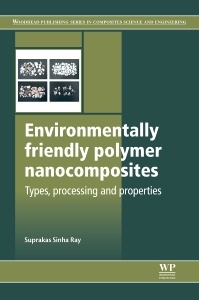Environmentally Friendly Polymer Nanocomposites Types, Processing and Properties Woodhead Publishing Series in Composites Science and Engineering Series
Auteur : Ray Suprakas Sinha

About the author
Woodhead Publishing Series in Composites Science and Engineering
Preface
Part I: Types, processing and characterization
Chapter 1: Introduction to environmentally friendly polymer nanocomposites
Abstract:
1.1 Introduction
1.2 Defining environmentally friendly polymer nanocomposites
1.3 Environmentally friendly polymer matrices
1.4 Environmentally friendly nanofillers/reinforcements
1.5 Processing of environmentally friendly polymer nanocomposites
1.6 Solution-blending and in-situ polymerization
1.7 Melt-blending
1.8 Performance and potential of environmentally friendly polymer nanocomposites
Chapter 2: Environmentally friendly polymer matrices for composites
Abstract:
2.1 Introduction
2.2 Mechanisms of biodegradation and classification of biodegradable polymers
2.3 Biodegradable polymers derived from renewable sources
2.4 Biodegradable polymers derived from fossil-fuel resources
2.5 Summary: using biodegradable polymers as matrices
Chapter 3: Environmentally friendly nanofillers as reinforcements for composites
Abstract:
3.1 Introduction
3.2 Nanoclays as reinforcements
3.3 Carbon nanotubes (CNTs) as reinforcements
Chapter 4: Techniques for characterizing the structure and properties of polymer nanocomposites
Abstract:
4.1 Introduction
4.2 X-ray diffraction (XRD) and small-angle X-ray scattering (SAXS)
4.3 Transmission electron microscopy (TEM) and electron tomography
4.4 Scanning transmission electron microscopy (STEM)
4.5 Scanning electron microscopy (SEM) and focused-ion beam SEM (FIB-SEM)
4.6 Atomic force microscopy (AFM)
4.7 Optical microscopy (OM) and polarized optical microscopy (POM)
4.8 Infrared (IR) spectroscopy
4.9 Other techniques
Chapter 5: Environmentally friendly polymer nanocomposites using polymer matrices from renewable sources
Abstract:
5.1 Introduction
5.2 Poly(lactic acid) (PLA)-based polymer nanocomposites
5.3 Polyalkanoate (PHA)-based polymer nanocomposites
5.4 Starch-based polymer nanocomposites
5.5 Cellulose-based polymer nanocomposites
5.6 Chitosan-based polymer nanocomposites
5.7 Protein-based polymer nanocomposites
Chapter 6: Environmentally friendly polymer nanocomposites using polymer matrices from fossil fuel sources
Abstract:
6.1 Introduction
6.2 Poly(butylene succinate) (PBS)-based polymer nanocomposites
6.3 Poly[(butylene succinate)-co-adipate] (PBSA)-based polymer nanocomposites
6.4 Poly(e -caproloctone) (PCL)-based polymer nanocomposites
6.5 Poly(butylene adipate-co-terephthalate) nanocomposites
6.6 Nanocomposites of other biodegradable polyesters
Chapter 7: Processing of environmentally friendly polymer nanocomposite foams for packaging and other applications
Abstract:
7.1 Introduction
7.2 Preparation, characterization and properties of environmentally friendly polymer nanocomposite (EFPN) foams
Part II: Properties
Chapter 8: Tensile properties of environmentally friendly polymer nanocomposites using biodegradable polymer matrices and clay/carbon nanotube (CNT) reinforcements
Abstract:
8.1 Introduction
8.2 Tensile properties of environmentally friendly polymer nanocomposites (EFPNCs) using clay reinforcements
8.3 Tensile properties of EFPNCs using carbon nanotube (CNT) reinforcements
Chapter 9: Dynamic mechanical properties of environmentally friendly polymer nanocomposites using biodegradable polymer matrices and clay/carbon nanotube (CNT) reinforcements
Abstract:
9.1 Introduction
9.2 Dynamic mechanical properties of environmentally friendly polymer nanocomposites using clay reinforcements
9.3 Dynamic mechanical properties of environmentally friendly polymer nanocomposites using carbon nanotube (CNT) reinforcements
Chapter 10: Thermal stability and flammability of environmentally friendly polymer nanocomposites using biodegradable polymer matrices and clay/carbon nanotube (CNT) reinforcements
Abstract:
10.1 Introduction
10.2 Thermal stability of environmentally friendly polymer nanocomposites using clay reinforcements
10.3 Thermal stability of environmentally friendly polymer nanocomposites using carbon nanotube (CNT) reinforcements
10.4 Fire resistant properties of environmentally friendly polymer nanocomposites using biodegradable polymer matrices and clay/carbon nanotube (CNT) reinforcements
Chapter 11: Barrier properties of environmentally friendly polymer nanocomposites using biodegradable polymer matrices and clay/carbon nanotube (CNT) reinforcements
Abstract:
11.1 Introduction
11.2 Gas barrier properties
11.3 Water vapor permeability and water swelling behavior
Chapter 12: Crystallization behavior, kinetics and morphology of environmentally friendly polymer nanocomposites using biodegradable polymer matrices and clay/carbon nanotube (CNT) reinforcements
Abstract:
12.1 Introduction
12.2 Isothermal and non-isothermal crystallization kinetics
12.3 Crystallization of clay-reinforced polymer nanocomposites
12.4 Crystallization of carbon nanotube (CNT)-reinforced polymer nanocomposites
Chapter 13: Biodegradation behavior of environmentally friendly polymer nanocomposites using biodegradable polymer matrices and clay/carbon (CNT) reinforcements
Abstract:
13.1 Introduction
13.2 Biodegradation behavior of environmentally friendly polymer nanocomposites using clay reinforcements
13.3 Biodegradable behavior of environmentally friendly polymer nanocomposites using carbon nanotube (CNT) reinforcements
Chapter 14: Rheological properties of environmentally friendly polymer nanocomposites (EFPNCs) using biodegradable polymer matrices and clay/carbon nanotube (CNT) reinforcements
Abstract:
14.1 Introduction
14.2 Dynamic oscillatory shear measurements
14.3 Steady shear measurements
14.4 Elongation flow rheology
Chapter 15: Electrical and thermal conductivity of environmentally friendly polymer nanocomposites (EFPNCs) using biodegradable polymer matrices and clay/carbon nanotube (CNT) reinforcements
Abstract:
15.1 Introduction
15.2 Electrical conductivity
15.3 Thermal conductivity
Part III: Summary
Chapter 16: Applications, environmental impact and future development of environmentally friendly polymer nanocomposites (EFPNCs)
Abstract:
16.1 Introduction
16.2 Applications of environmentally friendly polymer nanocomposites
16.3 Assessing the environmental impact of environmentally friendly polymer nanocomposites
16.4 Current challenges facing environmentally friendly polymer nanocomposites
16.5 Future trends
Index
- Summarises the practical implications of the development of nanoscale reinforcements for sustainable composite materials made from natural materials
- Examines matrix and reinforcement materials and their characterisation and reviews key properties such as tensile and dynamic mechanical properties
- Considers barrier properties, biodegradability, rheology, electrical and thermal conductivity and potential applications
Date de parution : 07-2013
Ouvrage de 512 p.
15.5x23.2 cm



